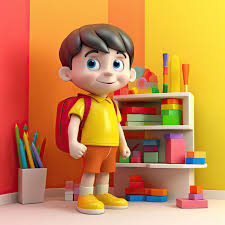The modern classroom has evolved dramatically over recent decades, with innovative teachers discovering new methods to capture students’ attention and enhance learning experiences. Among these methods, kids animated shows have emerged as surprisingly effective educational tools that extend far beyond their entertainment value. These colorful, engaging programs offer structured narratives and character-driven lessons that align remarkably well with developmental learning objectives for young children.
Experienced educators recognize that animated content can serve as powerful scaffolding for complex concepts. When a beloved character navigates a mathematical problem or demonstrates scientific principles, students often display heightened attention and improved retention compared to traditional instruction methods. This phenomenon has prompted educational researchers to explore the cognitive mechanisms behind animation-based learning and its applications across diverse subject areas and learning styles.
The effectiveness of animated content in educational settings stems partly from its multimodal presentation. By simultaneously engaging visual, auditory, and narrative processing centers in the brain, these shows create multiple pathways for information acquisition and retention. Educational psychologist Dr. Maria Montessori noted decades ago that children learn best through experiences that engage multiple senses simultaneously—a principle that quality animated content naturally embodies through its combination of movement, color, sound, and storytelling.
Subject matter integration represents another significant advantage of animated shows in educational contexts. Programs like “The Magic School Bus” seamlessly weave scientific concepts into engaging adventures, while shows such as “Cyberchase” make mathematical problem-solving exciting and accessible. These productions demonstrate that learning content doesn’t require sacrificing entertainment value, creating experiences that children actively seek rather than passively endure.
Character identification plays a crucial role in the educational impact of animated shows. When students connect emotionally with characters who demonstrate curiosity, perseverance, and critical thinking, they often internalize these traits and apply them to their own learning challenges. Teachers can leverage these connections by referencing character behaviors during classroom activities, creating continuity between screen-based models and real-world applications.
The pandemic period accelerated exploration of media-based learning as remote education became necessary. Many teachers discovered that carefully selected animated content could maintain student engagement during challenging circumstances, particularly for younger learners struggling with extended periods of screen-based instruction. These emergency adaptations have evolved into intentional instructional strategies that persist in post-pandemic classrooms.
Educational animation has demonstrated particular effectiveness for students with diverse learning needs. Children on the autism spectrum often respond positively to the predictable structures and visual clarity of animated content. Similarly, students with attention challenges frequently maintain focus longer when educational concepts are presented through animated sequences rather than traditional lecture formats.
Cultural representation within animated educational content has improved significantly in recent years, offering teachers valuable resources for promoting inclusivity and global awareness. Shows featuring diverse characters, international settings, and multicultural perspectives help students develop appreciation for differences while recognizing shared human experiences across various communities and backgrounds.
Professional development resources now frequently address media literacy and content integration skills. Organizations like the National Association for Media Literacy Education provide teachers with evaluation frameworks for selecting animated content aligned with both academic standards and age-appropriate developmental objectives. These resources help educators make informed choices about which shows truly offer educational value versus those providing mere entertainment.
Parents sometimes express concern about screen time in educational settings, requiring teachers to clearly communicate the intentional, limited use of animated content within broader instructional strategies. Successful educators emphasize that animated shows serve as supplements rather than replacements for teacher-led instruction, hands-on activities, and interpersonal learning experiences.
The most effective applications occur when teachers extend animated content through related activities. Discussion questions, creative projects, and problem-solving challenges connected to show content transform passive viewing into active learning experiences. These extensions help students transfer knowledge from animated contexts to real-world applications, strengthening both retention and practical application skills.
Research continues to validate the effectiveness of thoughtfully integrated animated content. A longitudinal study by the Joan Ganz Cooney Center demonstrated that kindergarten and first-grade students exposed to curriculum-aligned animated content showed significant advantages in vocabulary acquisition and reading readiness compared to control groups. These findings support the intentional incorporation of quality animated shows within comprehensive early literacy programs.

